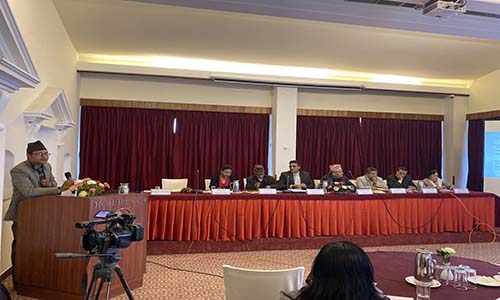Kathmandu, 17 January: The latest
research on the relations between remittance and self-employment finds that
remittance-recipients tend to reduce their labour supply in non-farm
self-employment. These findings suggest that strong policy measures are needed
to create conditions that make non-farm self-employment a vocation of
enthusiastic entrepreneurs rather than the occupation of reluctant ones.
These findings were presented at an
interaction programme ‘Leveraging remittances for economic transformation’
organized today by South Asia Watch on Trade, Economics and Environment
(SAWTEE) to disseminate the findings of the research which assessed
the impact of remittances from international migration on the non-farm
self-employment activities of left-behind household members. “A doubling
of remittances led an individual to supply on average 2.7 fewer hours to
non-farm self-employment per week. Higher remittances reduce labour hours
supplied to self-agriculture and salaried employment, too. A doubling of
remittances led an individual to supplied, per week, an average of nearly 1.6
fewer hours to agricultural self-employment and nearly 2.4 fewer hours to
salaried employment,” pointed out Dr. Paras Kharel, Research Director, SAWTEE
who led the research while making a presentation
The findings show that higher
remittance amounts are linked to left-behind women working fewer hours and
lower revenues for household enterprises. They tend to work 3.6 fewer hours (on
average) in non-farm self-employment, per week and the supplied 1.6 fewer hours
worked in agricultural self-employment and 3.4 fewer hours in wage employment
(on average). Although hours spent on household chores (collecting firewood,
fetching water, etc) increase slightly, there is a reduction in total hours
worked. Similarly, the investigation of productive use of remittances reveals
that, in line with the decline in the hours supplied to non-farm
self-employment, higher remittances also led to lower gross revenues of
non-farm enterprises operated by the left-behind labour force. A 10 percent
increase in remittances led to a 0.5 percent drop in gross revenue.
This empirical analysis, which builds
on a nationally representative household survey in Nepal for the year 2010/11,
finds the disincentive effect of higher remittances dominate channels such as
credit relaxation through which remittances may have a positive impact on firm
performance. This may have happened because those operating non-farm
enterprises, mostly micro- or smallscale, were “reluctant entrepreneurs” who
were engaged in the vocation out of desperation. Thus, the findings of the
research
Dr. Ganesh Gurung, Executive
Chairperson, Policy Research Institute, said channelling remittance to
productive use should start before the departure of the migrant workers. “There
should be a thorough orientation of the migrant workers regarding methods of
savings and investment while they are preparing for departure,” he said.
Dr. Posh Raj Pandey, Chairman, SAWTEE,
said the country’s failure to stem the flow of migrants and to divert
remittances as a productive financial resource is a policy failure. "But,
we can take remittance as medium-term a cushion and divert remittance into
productive use would require enabling logistical and policy environment,"
he said.
Mr. Gyan Chandra Acharya, former
foreign secretary and chair of SAWTEE-Centre for Sustainable Development,
pointed out the lack of coherent policy framework at the national level for
directing remittance to productive use.
Dr. Gunakar Bhatta, Executive Director,
Nepal Rastra Bank, pointed out the central bank’s efforts towards guiding
remittances for productive use. “Although subscription rates of foreign
employment bonds are not encouraging, we are hoping that delegating provincial
governments to issue these bonds could yield positive results,” he said.
With regard to the findings that show
reduced labour hours of the recipients, Mr. Dinesh Bhattarai, Joint-Secretary,
Ministry of Industry, Commerce and Supplies, called attention to risk-aversive
nature of micro- and small-entrepreneurs. “We need to look into policy measures
to incentivize such entrepreneurs towards growth,” he added.
Ms. Anjana Tamrakar, Vice President,
Federation of Nepal Cottage and Small Industries, agreed that without improving
the policy environment and complementary infrastructure, entrepreneurs will not
remain in the business.
Dr. Amina Maharjan, Livelihoods
Specialist, International Centre for Integrated Mountain Development (ICIMOD),
insisted that policies should also look into the reasons contributing to low
entrepreneurial tendencies, particularly among women, for instance, time
constraints they face and gender norms discouraging their entrepreneurial
tendencies, and hence bring about an enabling environment.
The research was carried out with
financial and scientific support from the Partnership for Economic Policy (PEP)
(www.pep-net.org) with funding from the Department for International Development
(DFID) of the United Kingdom (or UK Aid), and the Government of Canada through
the International Development Research Center (IDRC).

Agenda
Policy
Brief
Working Paper
Kantipur
Television
The
Himalayan Times